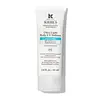What's inside
What's inside
 Key Ingredients
Key Ingredients

 Benefits
Benefits

 Concerns
Concerns

 Ingredients Side-by-side
Ingredients Side-by-side

Water
Skin ConditioningHomosalate
Skin ConditioningOctocrylene
UV AbsorberEthylhexyl Salicylate
UV AbsorberButylene Glycol
HumectantSilica
AbrasiveButyl Methoxydibenzoylmethane
UV AbsorberCaprylyl Methicone
Skin ConditioningC12-15 Alkyl Benzoate
AntimicrobialVp/Eicosene Copolymer
Dimethyl Capramide
Emulsion StabilisingPolyglyceryl-2 Stearate
EmulsifyingSaccharide Isomerate
HumectantTapioca Starch
Coriandrum Sativum Fruit Oil
MaskingCamellia Sinensis Leaf Extract
AntimicrobialSodium Ascorbyl Phosphate
AntioxidantSalix Alba Leaf Extract
Skin ConditioningTerpineol
MaskingThymol
AntimicrobialCitrus Aurantium Dulcis Peel Oil
MaskingDipotassium Glycyrrhizate
HumectantTocopherol
AntioxidantPotassium Cetyl Phosphate
EmulsifyingArachidyl Alcohol
EmollientGlyceryl Stearate Se
EmulsifyingPEG-100 Stearate
Behenyl Alcohol
EmollientBenzyl Alcohol
PerfumingXanthan Gum
EmulsifyingAcrylates/C10-30 Alkyl Acrylate Crosspolymer
Emulsion StabilisingArachidyl Glucoside
EmulsifyingEthylhexylglycerin
Skin ConditioningTocopheryl Acetate
AntioxidantTrisodium Ethylenediamine Disuccinate
Citric Acid
BufferingSodium Citrate
BufferingSodium Hydroxide
BufferingLinalool
PerfumingLimonene
PerfumingGeraniol
PerfumingCitronellol
PerfumingPhenoxyethanol
PreservativeWater, Homosalate, Octocrylene, Ethylhexyl Salicylate, Butylene Glycol, Silica, Butyl Methoxydibenzoylmethane, Caprylyl Methicone, C12-15 Alkyl Benzoate, Vp/Eicosene Copolymer, Dimethyl Capramide, Polyglyceryl-2 Stearate, Saccharide Isomerate, Tapioca Starch, Coriandrum Sativum Fruit Oil, Camellia Sinensis Leaf Extract, Sodium Ascorbyl Phosphate, Salix Alba Leaf Extract, Terpineol, Thymol, Citrus Aurantium Dulcis Peel Oil, Dipotassium Glycyrrhizate, Tocopherol, Potassium Cetyl Phosphate, Arachidyl Alcohol, Glyceryl Stearate Se, PEG-100 Stearate, Behenyl Alcohol, Benzyl Alcohol, Xanthan Gum, Acrylates/C10-30 Alkyl Acrylate Crosspolymer, Arachidyl Glucoside, Ethylhexylglycerin, Tocopheryl Acetate, Trisodium Ethylenediamine Disuccinate, Citric Acid, Sodium Citrate, Sodium Hydroxide, Linalool, Limonene, Geraniol, Citronellol, Phenoxyethanol
Water
Skin ConditioningAlcohol Denat.
AntimicrobialDiisopropyl Sebacate
EmollientIsopropyl Lauroyl Sarcosinate
Skin ConditioningEthylhexyl Triazone
UV AbsorberPropylene Glycol
HumectantBis-Ethylhexyloxyphenol Methoxyphenyl Triazine
Skin ConditioningDiethylamino Hydroxybenzoyl Hexyl Benzoate
UV FilterTitanium Dioxide
Cosmetic ColorantGlycerin
HumectantMethyl Methacrylate Crosspolymer
Drometrizole Trisiloxane
UV AbsorberTocopherol
AntioxidantStearic Acid
CleansingPhenoxyethanol
PreservativeCetyl Alcohol
EmollientPalmitic Acid
EmollientStyrene/Acrylates Copolymer
Ceteth-10
EmulsifyingCaprylyl Glycol
EmollientMenthoxypropanediol
MaskingDextrin Palmitate
EmulsifyingAcrylates/C10-30 Alkyl Acrylate Crosspolymer
Emulsion StabilisingAluminum Hydroxide
EmollientAmmonium Polyacryloyldimethyl Taurate
Emulsion StabilisingButylene Glycol
HumectantPotassium Hydroxide
BufferingPEG-8 Laurate
EmulsifyingDisodium EDTA
Adenosine
Skin ConditioningMyristic Acid
CleansingGentiana Lutea Root Extract
Skin ConditioningPentylene Glycol
Skin ConditioningMentha Piperita Extract
CleansingButyrospermum Parkii Seedcake Extract
Skin ProtectingRosa Gallica Flower Extract
AstringentSorbitol
HumectantMoringa Oleifera Seed Extract
Skin ConditioningDisodium Phosphate
BufferingCitric Acid
BufferingWater, Alcohol Denat., Diisopropyl Sebacate, Isopropyl Lauroyl Sarcosinate, Ethylhexyl Triazone, Propylene Glycol, Bis-Ethylhexyloxyphenol Methoxyphenyl Triazine, Diethylamino Hydroxybenzoyl Hexyl Benzoate, Titanium Dioxide, Glycerin, Methyl Methacrylate Crosspolymer, Drometrizole Trisiloxane, Tocopherol, Stearic Acid, Phenoxyethanol, Cetyl Alcohol, Palmitic Acid, Styrene/Acrylates Copolymer, Ceteth-10, Caprylyl Glycol, Menthoxypropanediol, Dextrin Palmitate, Acrylates/C10-30 Alkyl Acrylate Crosspolymer, Aluminum Hydroxide, Ammonium Polyacryloyldimethyl Taurate, Butylene Glycol, Potassium Hydroxide, PEG-8 Laurate, Disodium EDTA, Adenosine, Myristic Acid, Gentiana Lutea Root Extract, Pentylene Glycol, Mentha Piperita Extract, Butyrospermum Parkii Seedcake Extract, Rosa Gallica Flower Extract, Sorbitol, Moringa Oleifera Seed Extract, Disodium Phosphate, Citric Acid
Ingredients Explained
These ingredients are found in both products.
Ingredients higher up in an ingredient list are typically present in a larger amount.
Acrylates/C10-30 Alkyl Acrylate Crosspolymer is a synthetic polymer. It is used to thicken and improve the texture of products. Due to its properties, it can prevent water and oil ingredients from separating.
Butylene Glycol (or BG) is used within cosmetic products for a few different reasons:
Overall, Butylene Glycol is a safe and well-rounded ingredient that works well with other ingredients.
Though this ingredient works well with most skin types, some people with sensitive skin may experience a reaction such as allergic rashes, closed comedones, or itchiness.
Learn more about Butylene GlycolCitric Acid is an alpha hydroxy acid (AHA) naturally found in citrus fruits like oranges, lemons, and limes.
Like other AHAs, citric acid can exfoliate skin by breaking down the bonds that hold dead skin cells together. This helps reveal smoother and brighter skin underneath.
However, this exfoliating effect only happens at high concentrations (20%) which can be hard to find in cosmetic products.
Due to this, citric acid is usually included in small amounts as a pH adjuster. This helps keep products slightly more acidic and compatible with skin's natural pH.
In skincare formulas, citric acid can:
While it can provide some skin benefits, research shows lactic acid and glycolic acid are generally more effective and less irritating exfoliants.
Most citric acid used in skincare today is made by fermenting sugars (usually from molasses). This synthetic version is identical to the natural citrus form but easier to stabilize and use in formulations.
Read more about some other popular AHA's here:
Learn more about Citric AcidPhenoxyethanol is a preservative that has germicide, antimicrobial, and aromatic properties. Studies show that phenoxyethanol can prevent microbial growth. By itself, it has a scent that is similar to that of a rose.
It's often used in formulations along with Caprylyl Glycol to preserve the shelf life of products.
Tocopherol (also known as Vitamin E) is a common antioxidant used to help protect the skin from free-radicals and strengthen the skin barrier. It's also fat soluble - this means our skin is great at absorbing it.
Vitamin E also helps keep your natural skin lipids healthy. Your lipid skin barrier naturally consists of lipids, ceramides, and fatty acids. Vitamin E offers extra protection for your skin’s lipid barrier, keeping your skin healthy and nourished.
Another benefit is a bit of UV protection. Vitamin E helps reduce the damage caused by UVB rays. (It should not replace your sunscreen). Combining it with Vitamin C can decrease sunburned cells and hyperpigmentation after UV exposure.
You might have noticed Vitamin E + C often paired together. This is because it is great at stabilizing Vitamin C. Using the two together helps increase the effectiveness of both ingredients.
There are often claims that Vitamin E can reduce/prevent scarring, but these claims haven't been confirmed by scientific research.
Learn more about TocopherolWater. It's the most common cosmetic ingredient of all. You'll usually see it at the top of ingredient lists, meaning that it makes up the largest part of the product.
So why is it so popular? Water most often acts as a solvent - this means that it helps dissolve other ingredients into the formulation.
You'll also recognize water as that liquid we all need to stay alive. If you see this, drink a glass of water. Stay hydrated!
Learn more about Water